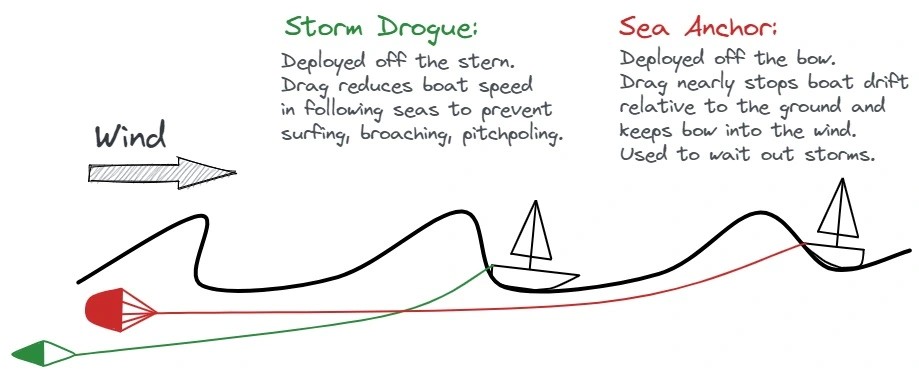Drogue and Sea Anchor
Even if running under bare poles, you may have too much speed. There are several ways to decrease the speed to avoid pitch poling or broaching. For example, using warps (a line trailing behind the boat 200 feet or longer), a chain with anchor, or deploying a drogue. You should practice using your drogue in various conditions. These are difficult-to-handle devices, and the load generated by them is enormous. Speed-limiting drogues should be deployed two waves back to keep it from being jerked out of the face of the wave as the boat accelerates toward the trough. Once you deploy it, the tensions will likely be too big for you to be able to adjust it, so you need to plan how much line you should pay out before deploying.
Drag devices help stabilize a boat in survival conditions. Waves tend to be steep and break early in the storm. This is because the underlying water is not yet moving at speed with the wind. During that period, drogues or towing other objects like warps stabilize the boat. After the storm, the winds have been blowing for 48 hours or more, the waves become less steep, but their velocity increases considerably. Drag devices may then slow the boat too much in front of the fast-moving waves. Cutting the drag devices away may allow the boat to rise up and go over the waves more smoothly, but only if the boat is actively steered to avoid breaking seas.
If you do plan to use a drogue, deploy it before the bad weather hits.

Attached to the bow, a sea anchor can prevent the vessel from turning broadside to the waves and being overwhelmed by them. The main difference between the sea anchor and the drogue is that the drogue will slow the boat while keeping the heading steady, and is intended to be launched from the stern. The parachute anchor is designed to be launched from the bow and effectively stop the boat's progress relative to the current in an open sea.
Most larger sea anchors will provide a mechanism to collapse the anchor for retrieval. This is called a trip line, and attaches to the rear of the anchor, allowing it to be pulled in back first, shedding water rather than filling.